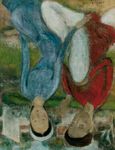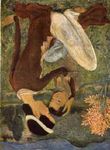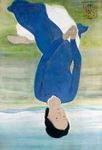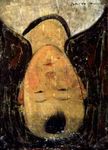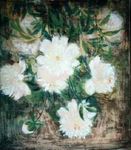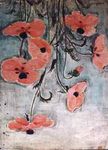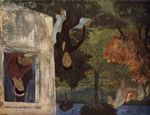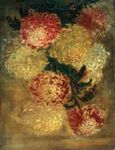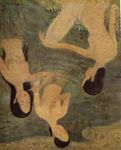Vu Cao Dam - Catalogue raisonné AAP
←
→
Page content transcription
If your browser does not render page correctly, please read the page content below
Vu Cao Dam
which formed the Mandarins and French
teachers for the colonial Regime.
As a family man, according to Vu Cao Dam
younger brother Vu Cong Thuyet in a mem-
oir destined to his children, Vu Dinh Thi was
the typical patriarch: “extremely severe with his
own children, who wanted absolute obedience. All of
them had to work assiduously, get the first places and
even the slightest failure deserved physical punish-
ment.”
However Vu Cao Dam’s mother was kind-
ness personified and all her children while
fearing their father’s presence, worshipped
her and always looked for her company, guid-
ance and comfort.
Vu Cao Dam was born in a traditional house
built by his father close to the Cathedral and
the Rice Market, Ngo Gac street (rue des
briques) nº 4, since his mother to whom Vu
Cao Dam’s father was extremely devoted was
Vu Cao Dam (1908-2000), Portrait of Victor Tardieu,
Vu Cao Dam, Hanoi 1926 a fervent catholic and traded with rice. Ac- Hanoi 1927, bronze, École des Beaux-Arts, Hanoi
cording to Vu Cong Thuyet: “Everybody agreed
that she had an exceptional intelligence and could do
Vu Cao Dam, was born January 8th 1908 in incredibly fast mental calculation even though she didates were admitted on the 60 to 100 who
Hanoi, the son of Vu Dinh Thi and Pham could not read or write. She died in May 1930 aged applied for the selection. There he took
Thi Cuc. He was the 5th of 14 children of 53 and her husband died in November of the same drawing, painting and sculpture classes. Dur-
whom 9 reached adulthood. The family came year aged 66.” ing the 5 years his studies lasted, Victor
from Trinh-Xuyen (today Liên Bao) district In 1926 Vu Cao Dam entered the “École des Tardieu, Founder of the School, never
of Vu Ban, province of Nam Dinh. Beaux-Arts” of Hanoi. From 1925 to 1945, ceased to encourage him. His main teachers
His father Vu Dinh Thi (1864-1930) 4th of 5 according to the year, some eight to ten can- were: Victor Tardieu for painting, Joseph In-
children, was born in a family converted to guimberty for Decoration, Batteur for Ar-
Catholicism since the XVIIIth century. The chitecture, Dr Phénix for anatomy, and
family situation being satisfactory, Vu Cao Goloubew for medicine.
Dam’s father went to school at a very tender Every year a professor of painting or draw-
age and since early childhood became profi- ing, who held the title of the Indochina
cient at Chinese calligraphy. He also studied Prize, came to teach at the Academy of Fine
Latin, Spanish and French, but had a true Arts.
veneration for Confucius and a great love Victor Tardieu dedicated himself totally to
and knowledge of Chinese literature. his beloved School. Not only did he teach
At the time, he was one of the few Viet- painting and the means to succeed in that
namese who perfectly mastered the French field, but he wanted to insure for his pupils
language and for that reason he was sent to the best possible material conditions so they
Paris by the Government on the occasion of could accomplish their work in utmost seren-
the Universal Exhibition in 1889. He was ity.
conquered by French people’s kind and ele- As Vu Cao Dam himself wrote: “It would be
gant manners and kept wonderful memories very hard today to find such a dedicated, enlightened
of his stay. Later on, he tried to convey to his and devoted Master. But this devotion was accompa-
children his admiration and taste for French nied by an incredible exactingness and required an
Culture. At the age of 30 he married Pham exemplary discipline. Students were supposed to work
Thi Cuc (1877-1931) then aged 17, also a many hours a day and produce works of high qual-
Catholic. ity. Up at 6 o’clock, the day started by a class of
He was what French people used to call “un Vu Gao Dam (1908-2000), Portrait of his father, Vu academy. In the afternoon: decoration; once a week
lettré”. In 1886 he founded and directed all Dinh Thi, Hanoi 1927, bronze, head: 32 x 18 x 22 cm, one hour of anatomy and one hour of perspective.
his life the School of Interpreters of Hanoi, socle: 14, 8 x 14, 5 x 14,5 cm, Fundación Yannick y
Also classes of modelling, – with “relevé” of pago-
Ben Jakober, Alcudia
1From left to right and top to bottom:
“Young Girls Playing”, watercolour on silk, Hanoi 1926-
27
“Head of a Man with a Mandarin Hat”, 1930. bronze, H
70 cm, Museum of Fine Arts, Hanoi
Vu Cao Dam in front of one of the monumental low-
relief, Hanoi 1930 circa
“Hen”, bronze, 1928, H 21 cm
“Portrait of a Young Vietnamese”, bronze, 1928
These works were all done in Hanoi during his stay at
the École des Beaux-Arts d’Indochine
2das, temples and historical monuments (discipline
at which Vu Cao Dam excelled according to
Jean Tardieu).”
Because of his strict family upbringing, for
Vu Cao Dam The “École des beaux-Arts” rig-
orous time-table was certainly not exacting.
He even found time before six o’clock to run
a few miles or play a game of tennis with an-
other early riser and then face the mandatory
nine hours of class.
In spite of his father’s authoritarian charac-
ter, Vu Cao Dam childhood was a very happy
one and since he was among the youngest
sons, he never had to bear the strain and re-
sponsibility of the eldest. He was surrounded
by the affection of his brothers, sisters and
of his mother.
According to one of his sisters he was a
rather turbulent and gifted child, very clever
physically, full of vitality and fantasy, with a
passion for sport, in particular soccer, but
above all endowed of an incredible appetite
for life. He practiced all sports including Chi-
nese Boxing (Boxe chinoise). While still very
small, as goes the legend, he stole one of his
mother jade rosary and using the beads as
marbles he triumphantly came back home
having doubled his bet. At the age of 10 he
used to go regularly to the velodrome with
his bicycle and later on he assiduously prac-
ticed tennis at which he soon excelled. In this
way he met Bao Daï, with whom he fre-
quently played on public and private courts
indifferently. Years later when Bao Dai went
to Paris, the sovereign asked for Vu Cao
Dam whom he knew to be there and in this
way they resumed their tennis games in the
French capital. It is at that time that he made
his bust, now part of the Musée du Quai
Branly collection.
During his studies he executed the bust of
his father, heads of young girls among which
the “Young Vietnamese Girl” now exhibited at
the Museum of Fine Arts of Hanoi and who
in reality was a young girl named Hue part of
the House staff and later on he did Victor
Tardieu’s bust. Detecting his precocious and
Top: Vu Cao Dam painting from nature, Hanoi 1926- Top: Vu Gao Dam posing in front of his sculpture
unusual talent as a sculptor the latter advised 27 “Nude” at the sage of clay. The plaster was exhibited in
him to choose that section right from the Above: Vu Cao Dam, top right, École des Beaux Arts 1931at the Colonial Exhibition in Paris, now Musée du
first year. He was totally at ease in this ex- d’Indochine, 1928 circa, in the foreground “Tête de Quai Branly, Paris. He is wearing the mourning arm-
pression and specialised in portraits. Jeune Fille”, now Musée du Quai Branly, Paris band so the picture must have been taken in 1930-31
During these years of formation in Hanoi,
the painters he discovered and admired most of every year Victor Tardieu used to organ- 1926-31, one can mention: “Head of a Young
were: Italian Primitives, Gauguin, Van Gogh, ise exhibitions, which allowed them to work Vietnamese (Tête d’Indochinoise)” 1927-28 circa,
French Impressionists in general and most without any economical preoccupation and “Young Peasant Girl”, bronze, 1927, “Head of a
particularly Renoir, Bonnard, the Fauves and at the same time realise some material bene- man”, stone, 1927, the bust of his father “Vu
equally Matisse and Modigliani. For sculpture fits. Dinh Thi”, bronze, 1927, “Rooster”, bronze,
his art had a natural link with Kmer tradition In 1928 Victor Tardieu organised a collective 1927, “Hens”, bronzes 1928, “Victor Tardieu”’s
but was especially influenced by Chinese exhibition with works of Le Pho, Vu Cao bust, bronze, 1928, “Young Vietnamese”,
Sculpture. Dam and Mai Trung Thu. Among the sculp- bronze, 1928, “Nude”, plaster, 1930 circa,
To help his students economically, at the end tures of Vu Cao Dam during the period “Man with a Mandarin Hat”, 1930 circa, and
3in France. He left in November 1931 and
borded the D’Artagnan. He travelled in com-
pany of Colette Reynaud, later Mrs Dernis,
the daughter of French Minister Paul Rey-
naud and during the long journey made her
bust. In a short letter sent to his sister from
Colombo, he related his journey and men-
tioned this sculpture.
Once in Paris he first resided at the Cité Uni-
versitaire which must still keep one of his
sculpture inspired by a Kmer head of a Bud-
dah. He had participated to the Colonial Ex-
hibition in 1931, whose Commissioner was
Marshal Lyautey, under the patronage of
Paul Reynaud, with Le Pho and Georges
Khanh among other artists, so at his arrival
his name was already beginning to be known
in the artisrtic circles.
Later on in 1936-37 he shared an apartment
Avenue de Saxe with Mai Thu.
Shortly after his arrival in the French capital,
he executed the busts of Minister Paul Rey-
naud. He studied at the École du Louvre in
the Extrême-Orient section. He was com-
missioned the bust of Albert Sarraut then
Minister of the Colonies and under his pa-
tronage he exhibited his works at the Maison
de l’Indochine. He discovered the works of
Rodin, Despiau, and later on of Giacometti.
His reputation as a sculptor brought him
right away numerous commissions: Jacques
Stern, Maurice Lehman, then Director of the
Châtelet Theatre, the Emperor Bao Dai al-
ready mentioned, Colonel de la Brosse,
Roger Bourdin —tenor at Paris Opera— ,
André Bauge, and many others.
To help his finances, in company of other
Vietnamese fellow students like Manh Don,
he acted as an extra in the Châtelet produc-
tions.
At the same time he painted on silk and ex-
hibited as a member at the Salons des
Artistes Indépendants, Artistes Français,
Salon d'Automne, and of the Tuileries. Many
From top left to right: Vu Cao Dam with Nguyen Tien
Phuc (who was doing Vu Cao Dam moulds) and of his works were bought by the State, some
Georges Kahn, in front of a monumental Low Relief of them by the Musée de la France d'Outre-
later shown at the Colonial Exhibition of Paris in mer. He was a Member of the jury of the the
1931, 1929-30
Competion for the « Meilleur ouvrier de
“Tête de Jeune Fille”, 1927 Hanoi, bronze, H 37 cm,
Musée du Quai Branly, Paris France ».
Vu Cao Dam’s letter to his sister aboard the d’Artag- In 1934, an edition of a bust of the head of
nan on his way to France 24 November 1931 a young Vietnamese was produced by the
Vu Cao Dam with his sisters Vu Thi Hong and Vu Thi
Manufacture of Sèvres.
Luu, his niece Lieu and his nephew Thuan aboard the
d’Artagnan just before his departure, 1931. He is still In 1936 he met Renée Appriou, a young pi-
wearing the mourning band on his arm anist who studied at the Scola Cantorum
monumental low relieves, executed with under the direction of Vincent d’Indy. They
Georges Khanh of the 1925-30 promotion. married in 1938 and had two children: Michel
In 1931 Vu Cao Dam ended his studies and born in 1941 and Yannick in 1942.
obtained a scholarship, which allowed him to In 1938 they moved to 32 rue Alphonse
go to France and complete his studies. Bertillon in the 15th “arrondissement” where
Both his parents having died he felt that the they stayed till after May 1940.
moment had come for him to pursue his goal War interrupted his career as a sculptor be-
4Opposite page, from left to right and from top to bot-
tom:
“Colette Reynaud”, 1931, original plaster
“Paul Reynaud” (1878-1966), Paris 1931
“Albert Sarraut”, (1872-1962), bronze
“Head of Buddha”, Khmer Art Musée Guimet, (XI-
XII°), “archives photographiques d'Art et d'Histoire”,
Paris
Vu Cao Dam posing with the “Head of a Buddha” in-
spired by Jayavarman VII head (Musée Guimet, Paris),
H. 160 cm, Cité Universitaire, Paris 1935
“Portrait of a Young Vietnamese”, Sèvres, 1934, H 33 cm
“Bao Dai” (1913-1997), stone, Paris 1931-32, Musée du
quai Branly, gift of Mrs Pasquier in 1937
Vu Cao Dam modelling the bust later on cast in
bronse of Maurice Lehman (1895-1974) director of
the Châtelet from 1928 to 1966. Notice the miniature
head on the left of the table
This page, from left to right and top to bottom:
“Portrait of Renée”, painting on silk, 1938, Fundación
Yannick y Ben Jakober, Alcudia
Vu Cao Dam in Paris, early thirties
Vu Cao Dam and Mai Thu in the sudio they share Av-
enue de Saxe, 1937
Party at rue de Saxe: first row on trhe left, Renée Ap-
priou, last row in the middle, Vu Cao dam, second row
on the right Mai Thu
In the atelier rue des Favorites: from left to right,
Renée Appriou, Vu Cao Dam holding the plaster bust
of Jean Tardieu, Andrée a friend, Dr Nguyen Huy
Tuoc, General Minh
6cause of the impossibility to cast bronze: its
fusion was forbidden and the metal requisi-
tioned by Germans.
He therefore dedicated himself entirely to
painting and only occasionally realised sculp-
tures modelled in clay, which were then fired
and given a special patina. He did a few busts
among which the ones of the French poet
Jean Tardieu (whom he had met in Hanoi
while Victor Tardieu’s son was doing his mil-
itary service in Indochina) and of his wife
Marie-Laure in 1937. A strong and lasting
friendship will unite the two men till their last
days. He frequented a literary and artistic cir-
cle that gravitated around the magazine Les
Lettres Françaises. With his family he moved
to 6 rue des Favorites, Paris 15th arrondisse-
ment in 1942.
During the war his wife and children moved
to the countryside to avoid bombardments
in a village called Marcilly near Romilly,
where a couple of their friends, Dr Doan and
his wife were established. Vu Cao Dam lived
between Paris and Marcilly where he went by
bicycle at night (not to be detected by the en-
nemy) and pedalled 120 km in the dark. His
friend Le Pho was Yannick’s Godfather,
while Dr Nguyen Huy Tuoc was Michel’s
Godfather.
In 1944 he moved to a big studio and ap-
partment at the 6th and 7th floor, avenue du
Parc Falbret in Vanves, near Paris. His friend
Mai Trung Thu, lived on the 5th floor of the
same building. He frequently saw his friend
Dr. Manh Don, with whom he played tennis
practically every day. Manh Don was the first
doctor to hold a chair of acupuncture in
Paris. He also was Matisse’s doctor and in his
office there was a Matisse drawing with the
following dedication: “To Doctor Manh Don my
saviour” of which he was rightly very proud.
In 1946 Vu Cao Dam held a one man show
at the Galerie Van Riek, Paris. The same year
Ho Chi Minh came to Paris, at first staying From left to right and from top to bottom:
in a hotel, then as the guest of Mr and Mrs Vu Dam modelling in clay the bust of Ho Chi Minh,
Aubrac at Soisy-sous-Montmorency. At the Paris 1946
“Maternity” 1946, painting on silk, Mr and Mrs Aubrac
same time Vu Cao Dam did the bust of Ho Collection, Paris
Chi Minh, a low relief medallion in terra Bronze version of Ho Chi Minh bust, Ho Chi Minh
cotta (now lost), and stroke a bronze com- Museum, Hanoi
memorative medal of Ho Chi Minh at the In Vu Cao Dam’s “atelier”, from Left to right, Le Thi
Luu, Mai Trung Thu, X, Michel Vu, Yannick Vu, Vu
“Hôtel de la Monnaie” of Paris. Cao Dam, Paris 1946
He offered Ho Chi Minh a silk painting “Ma-
ternité” who in his turn offered it to Mr and article in France Illustration. His Vietnamese
Mrs Aubrac shortly before the birth of their artists friends were Le Pho. Mai Thu his
third child (of which Ho Chi Minh will then neighour and also Le Thi Lu.
be the God-father). Mr and Mrs Aubrac kept Suffering for years from asthma and since
the painting all their life. some time seeing his health declining, Vu
Vu Cao Dam continued to paint composi- Cao Dam took the decision in 1949 to leave
tions and flowers on silk. Paris which climate was not favourable to his
The same year he exhibited his paintings on condition. His relative Can Do Dinh and his
silk and Jeanine Auboyer wrote an laudatory wife Nguyen Thi Kim (Vu Cao Dam’s niece
Anna) – their two little girls Marguerite and
7Angèle, joined them having fled Vietnam’s After a short journey to the Côte d’Azur in
hostilities. Together they estanlished them- May-June 1952, he met Alphonse Chave and
selves in Béziers at the end of 1949. thanks to him, established himself in Vence
A few months after they had moved to in July 1952, first at the Villa “Les Cadrans So-
Béziers, his son Michel fell gravely ill and his laires” on the Saint-Paul-de-Vence Road
wife Renée had to go back to Paris where the where his neighbour was painter Morris
child was operated twice. Far from Paris his Kestelman (1905-1998) who taught at the
painting took a more naturalistic turn, prob- Royal College of Arts and became a good
ably to meet the demands of a market which friend of his. In November he moved to the
was not as sophisticated as the Parisian one. Villa “Les Heures Claires” on the Road to
He did a few landscapes and his painting was Saint-Jeannet, close to the Matisse Chapel
definitely influenced by the Southern light and not far from the villa “Le Rêve” where
and French painting of the Renaissance (he Matisse used to live and a kilometre away
then did many paintings with tempera and from the villa “les Collines” where Chagall was
egg), but mainly he continued to paint scenes then residing.
reminiscent of Vietnam and his niece Anna From that house, he had a beautiful view of
who was quite beautiful, certainly inspired the old town of Vence and its remparts that
him in many compositions of women por- he would paint a certain number of times, till
traits and maternities. He travelled to Jean Dubuffet built his atelier which spoilt a
Toulouse and exhibited in the aerea. bit the view. His work was then influenced
by Chagall and the artists of the École de
Paris and he also discovered the “Art Brut”
with Dubuffet and Malaval who exhibited at
the Chave gallery. Vu Cao Dam befriended
Malaval whose talent and originality he ap-
preciated. Vu Cao Dam exhibited in Nîmes
Galerie Marcel Gueidan in December 1952.
In August 1954 He showed his work in Aix
en Provence, galerie “Les Amis des Arts”. Vu
Cao Dam met Paul Hervieu, who owned a
gallery in Nice, rue Pastorelli. He exhibited
regularly with him in Nice as well as abroad,
mainly in Sweden. Paul Hervieu represented
artists such as, Buffet, Clavé, César, Atlan,
Herbin, Coignard, etc... In November 1954
he exhibited in Mazamet. He also met
Sapone the taylor of the artists whose most
famous customer was Pablo Picasso. He ex-
changed paintings against tailored clothed
and if in most cases it was a fair deal in the
case of Picasso it definitively was a bonanza
for him. From this moment onward he
started to paint with oil, technique that he
will adopt definitely later on. He exhibited at
the Salons of Grasse, Cannes; he participated
to the Biennial of Menton and showed reg-
ularly at the Galerie Paul Hervieu in Nice and
Malmö. For a short period of time he rented
the studio of French caricaturist Paul
Gavarni (1801-1866) on the Saint-Paul-de-
Vence Road. These were fertile and inter-
esting years. His son’s health was slowly
improving and the artistic milieu of the Côte
d’Azur was stimulating. In 1957 he exhibited
in La Chaux de Fonds and Langenthal,
Switzerland.
In 1959 he established himself definitively in
From left to right and from top to bottom: Saint-Paul-de-Vence where he resided till his
Vu Cao Dam, Paris 1947
“Paysage” (Houses in Béziers), 1950, painting on silk, 22 x 33,5 cm, Fundación Yannick y Ben Jakober, Alcudia death in 2000. Chagall also moved to Saint-
“Mother crossing the River”, 1951, painting on silk, 61 x 45,5 cm, Fundación Yannick y Ben Jakober, Alcudia Paul-de-Vence and that village was a unique
“Mother and Child”, 1951, painting on silk, 22 x 14,5 cm place for artists to meet and also a stimulat-
“Vence”, 1954, oil on canvas. 64 x 49 cm, Fundación Yannick y Ben Jakober, Alcudia
8ing one to work.
In 1960 he exhibited in London at Frost &
Reed Gallery, then in Brussels in 1963. At the
end of that year he signed a contract with
Wally Findlay Gallery with which he exhib-
ited regularly later on in New York, Chicago,
Palm Beach and Los Angeles. He never went
to States to attend any opening.
It is only in 1985 that he resumed sculpture
during one of his stays in Majorca where he
went regularly every summer, first in Puerto
Pollensa in the seventies, then in Alcudia in
the eighties where he did the bust of his
daughter Yannick, his son in Law Ben
Jakober and of his two grand children Maima
and Reza.
During the last years of his life he suffered
from hypoglecemia that debilitated him. But
he painted till a very old age and also mod-
elled clay well into his late eigties. In 1997 Vu
Cao Dam wrote: “Today when one is going to-
wards a multicultural and multiracial expression, I
think that I have been among the first ones to have
attempted to conciliate my oriental roots without
From left to right and from top to bottom: breaking up with tradition with my perception of the
lessons drawn from the study of occidental culture
from left to right: Mrs X., Vu Cao Dam, Jacqueline
van der Stratten, Dr. Manh Don, Renée Vu, Patrick
great Masters.” In 2.000 he was made Officer
van der Stratten, Casa del Sol, Cap d’Antibes, New of the order of Merit.
Year’s Eve in the late fifties His wife Renée died in 2011. He is survived
by his son Michel, also a painter and sculptor,
From left to right: Vu Cao Dam, Marguerite Maeght,
Tal Coat, Dolores Juncosa (Miro’s wife), Aimé Maeght,
who now lives in Vence, and his daughter
picture taken at Aimé Maeght’s house at the occasion Yannick, a painter and sculptor, first married
of Fondation Maeght’s 10th birthday, Saint-Paul-de- to Italian artist Domenico Gnoli (1933-1970)
Vence, Summer 1974 with whom she resided in Majorca and
Vu Cao Dam, Saint-Paul-de-Vence, in the seventies
Rome. In 1972 she married Ben Jakober, also
and artist, and together they have founded
Marie-Laure Tardieu, Vu Cao Dam, Jean Tardieu, the “Fundación Yannick y Ben Jakober” in
Saint-Paul-de-Vence Alcudia, Majorca. One room is dedicated to
Vu Cao Dam, Sa Bassa Blanca, Alcudia, Majorca, 1986
the work of her father Vu Cao Dam and an-
other one to the drawings of Domenico
“Jeune Femme songeuse”, 1944 c., terracotta, 33 x 29 x 23 Gnoli. In an underground space is exhibited
cm part of a unique collection of portaits of
Children from the XVIth to the XIXth century.
In another space contemporary art is shown
with works of Domenico Gnoli, and a sculp-
ture park with works of Yannick Vu and Ben
Jakober on the theme of animals in Art His-
tory greets the visitors.
9From left to right and top to bottom:
“Lady in Pink”, 1938 circa, painting on silk, 55 x 46
cm, previously Pierre Le Tan collection
“Young Vietnamese Girl, 1938 circa, painting on silk
“Two Women”, 1938 circa, painting on silk, 88 x 60 cm
“Five Ladies from Hué, 1939, painting on silk, 84 x
113 cm
“Kneeling Woman”, 1940-45, terracotta, 27,5 x 21 cm
“Jeune fille réservée”, terracotta, h. 30 cm, 1940 circa
“The Tcheo Actor”, 1940, painting on silk, 39,5 x 25 cm
10From left to right and top to bottom:
“Portrait of a Vietnamese Mandarin”, Paris 1942
circa, painting on silk, 147 x 72 cm
“Young Lady in blue”, 1939, painting on silk, 92,5
x 64,5 cm
“Elegant conversation”, Paris 1944, painting on
silk, 61 x 81,5 cm
Opposite page:
“Lady in Blue”, 1939, painting on silk, 92 x 64
cm
“Maternity”, 1939 circa, painting on silk, 59 x 34
cm
“Portrait of a Young Girl”, 1938, painting on silk,
61 x 46 cm, National Art Gallery, Singapore
“Portrait of a Scholar”, 1936 circa, painting on
silk, 45,50 x 33 cm
1112
From left to right and top to bottom:
“Maternité”, Paris 1946, painting on silk
“La baignade”, Paris 1946 circa, painting on silk
“La Dame et Le Cavalier”, paris 1946 circa, painting on
silk
Opposite page:
“Poet”, 1940, painting on silk
“Jeune Femme Nue”, 1935 circa, painting on silk, 43 x
66 cm, National Art Gallery, Singapore
“Portrait of a Man”, 1941, painting on silk, 32,5 x 24
cm, Fundación Yannick y Ben Jakober, Alcudia
“Portrait of a little Girl”, 1940, painting on silk, Fun-
dación Yannick y Ben Jakober, Alcudia
1314
From left to right and top to bottom:
“Le Cavalier”, 1946, painting on silk, 55 x 45 cm, Fundación Yannick
y Ben Jakober, Alcudia
“Le jardin d’été”, 1944 circa, painting on silk, 60 x 45 cm, Fundación
Yannick y Ben Jakober, Alcudia
“Couple”, 1946. painting on silk, 35 x 27 cm
Opposite page:
“Liliums”, 1946/47, painting on silk, 67 x 53 cm, Fundación Yannick
y Ben Jakober, Alcudia
“Pavots”, 1946/47, painting on silk, 69 x 54 cm, Fundación Yannick
y Ben Jakober, Alcudia
“Pivoines”, 1946/47, painting on silk, 55 x 46 cm, Fundación Yannick
y Ben Jakober, Alcudia
“Chrysanthèmes”, 1946/47, painting on silk, 60 x 46 cm, Fundación
Yannick y Ben Jakober, Alcudia
1516
You can also read
